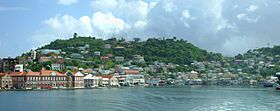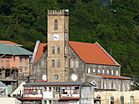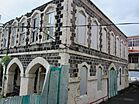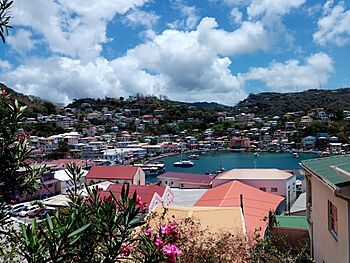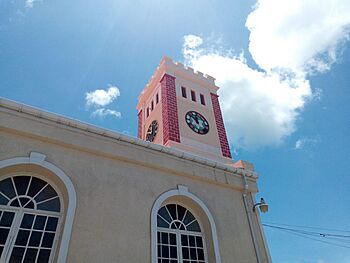St. George's, Grenada facts for kids
Quick facts for kids
St. George's
|
|
|---|---|
|
Top: St. George's skyline; Middle: Fort George, St. George's Cathedral; Bottom: Grenada's former Parliament House, St. George's Beach
|
|
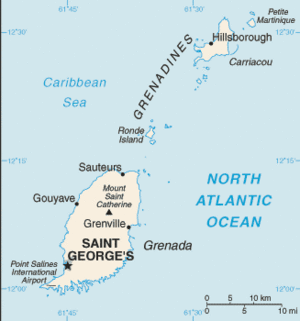
St.George within Grenada
|
|
| Country | Grenada |
| Parish | Saint George |
| First settled | 1650 |
| Population
(2012)
|
|
| • Total | 33,734 |
| Time zone | UTC-4 |
St. George's (in Grenadian Creole French: Sen Jòj) is the capital of Grenada. The city is built around an old volcano crater. It sits on a beautiful horseshoe-shaped harbour.
St. George's is a very popular place for tourists in the Caribbean. The town has grown a lot recently. But it has also kept its important history, culture, and natural beauty. The area where St. George's is located is home to St. George’s University School of Medicine. It also has the Maurice Bishop International Airport. The main things exported from St. George's are cocoa beans, nutmeg, and mace spice.
The city has a warm, tropical climate. This weather is perfect for growing spices. Nutmeg is the most important crop. Other key spices include cocoa, mace, cloves, vanilla, cinnamon, and ginger.
Contents
History of St. George's
St. George's was started by the French in 1650. This was when "La Grenade" (Grenada) became a French colony. Jacques Dyel du Parquet, the governor of Martinique, led this effort. The French settlement began with fights that almost completely wiped out the island's native Carib people.
In 1666, French settlers built a wooden fortification. It was on a hill overlooking Grenada's natural harbour. They called it Fort Royale. In 1705, work began on a new star fort in the same spot. This new fort had four stone bastions. It was designed by Jean de Giou de Caylus, a chief engineer for the French West Indies. The fort was finished in 1710.
The first French settlement was called Saint Louis. It was later known as Port Louis. But it often flooded and had problems with malaria. So, a new town was built called Ville de Fort Royal (meaning "Fort Royal Town"). In 1763, Grenada was given to Great Britain by the Treaty of Paris. The British then renamed the town Saint George's Town, after the patron saint of England. Fort Royal was also renamed Fort George, after King George III. On November 1, 1775, a big fire happened in St. George's. It was called the Great Fire of St. George's. After another big fire in 1771, many guesthouses moved to Gouyave.
In the mid-1880s, St. George's became the new capital of the British Windward Islands. This happened after Bridgetown, Barbados, was no longer the capital.
The Tikal was the first art shop in Grenada. It opened in December 1959. Grenada became independent from Britain in 1974. In 1983, there was a change in government. After this, U. S. troops came to the island. A government that supported the U.S. was then put in place. In 2004, Hurricane Ivan hit St. George's and the rest of Grenada very hard. The hurricane caused a lot of damage across the island. It ruined much of the island's buildings and roads. About 90% of homes were damaged. The nutmeg trees, which are very important to Grenada's economy, were also destroyed.
One year later, with help from other countries, Grenada had made great progress in rebuilding. Countries like Canada, the United States, China, Venezuela, Trinidad & Tobago, and the European Union helped. By 2007, Grenada was able to host games for the 2007 Cricket World Cup. Today, St. George's is one of the top 10 places for yachts to visit.
Culture and Festivals
Carnival is a big festival that happens in the second week of August. This festival celebrates when slaves were freed. The parties on Sunday night continue until early Monday morning. On Monday, a carnival show is held at Queen's Park. Here, people show off their costumes and themes. Calypso queens are also judged. On Tuesday, St. George's fills with the sounds of calypso steel bands. They parade through the streets, making music.
Climate and Weather
St. George's has a warm, humid tropical marine climate. It also has features of a tropical rainforest climate. There is a wet season from June to November. There is also a clear dry season from December to May. St. George's often has thunderstorms. Sometimes, hurricanes come from the east. Winter is a little cooler and drier. The heat feels stronger all year because of strong sunlight and high humidity.
| Climate data for St. George's, Grenada (Maurice Bishop International Airport) (1991-2020) | |||||||||||||
|---|---|---|---|---|---|---|---|---|---|---|---|---|---|
| Month | Jan | Feb | Mar | Apr | May | Jun | Jul | Aug | Sep | Oct | Nov | Dec | Year |
| Record high °C (°F) | 32.0 (89.6) |
32.0 (89.6) |
33.4 (92.1) |
32.9 (91.2) |
33.4 (92.1) |
33.5 (92.3) |
33.0 (91.4) |
33.3 (91.9) |
34.0 (93.2) |
34.0 (93.2) |
33.5 (92.3) |
32.7 (90.9) |
34.0 (93.2) |
| Mean daily maximum °C (°F) | 29.7 (85.5) |
29.7 (85.5) |
30.0 (86.0) |
30.5 (86.9) |
30.8 (87.4) |
30.6 (87.1) |
30.6 (87.1) |
31.0 (87.8) |
31.3 (88.3) |
31.1 (88.0) |
30.7 (87.3) |
30.2 (86.4) |
30.5 (86.9) |
| Daily mean °C (°F) | 26.5 (79.7) |
26.6 (79.9) |
26.9 (80.4) |
27.6 (81.7) |
28.1 (82.6) |
27.9 (82.2) |
27.7 (81.9) |
28.0 (82.4) |
28.3 (82.9) |
28.0 (82.4) |
27.6 (81.7) |
27.0 (80.6) |
27.5 (81.5) |
| Mean daily minimum °C (°F) | 23.3 (73.9) |
23.4 (74.1) |
23.9 (75.0) |
24.8 (76.6) |
25.4 (77.7) |
25.1 (77.2) |
24.9 (76.8) |
25.0 (77.0) |
25.3 (77.5) |
25.0 (77.0) |
24.5 (76.1) |
23.9 (75.0) |
24.5 (76.2) |
| Record low °C (°F) | 19.4 (66.9) |
20.1 (68.2) |
20.4 (68.7) |
20.6 (69.1) |
22.0 (71.6) |
21.2 (70.2) |
20.7 (69.3) |
21.7 (71.1) |
21.7 (71.1) |
21.9 (71.4) |
21.7 (71.1) |
19.9 (67.8) |
19.4 (66.9) |
| Average precipitation mm (inches) | 64.4 (2.54) |
38.6 (1.52) |
25.6 (1.01) |
36.4 (1.43) |
52.8 (2.08) |
126.5 (4.98) |
123.2 (4.85) |
142.6 (5.61) |
122.0 (4.80) |
149.9 (5.90) |
164.4 (6.47) |
105.3 (4.15) |
1,151.7 (45.34) |
| Average precipitation days (≥ 1 mm) | 10.6 | 6.9 | 5.3 | 5.0 | 7.0 | 14.3 | 15.3 | 14.9 | 11.3 | 14.2 | 14.7 | 12.0 | 131.5 |
| Source: NOAA | |||||||||||||
Spices of Grenada
Grenada is known as the "Spice Island." Many different spices are grown here.
Nutmeg and Mace
Nutmeg and mace come from the fruit of the Myristica fragrans tree. This tree was brought to the island on March 3, 1967. The nutmeg tree is an evergreen, meaning it stays green all year. It has dark green leaves and small yellow flowers. It can grow up to 12 meters (about 40 feet) tall. The tree starts to produce fruit after seven or eight years. It can keep producing fruit for up to 40 years!
The fruit looks like an apricot. When it's ripe, it splits open. Inside, you find a seed about the size of a walnut. This seed is used to make nutmeg powder. The seed is covered in lacy, red-orange strips. These strips are dried and ground into mace powder. Both nutmeg and mace are used a lot in cooking. They add flavor to cakes, soups, desserts, drinks, and sauces.
Cinnamon
Cinnamon comes from the inner bark of the cinnamon tree (Cinnamonum verum). You can find it as whole sticks or ground into powder. It's a very popular spice used in homes all over the world. People use it to flavor drinks and cakes.
Clove
Cloves are dried flower buds from the Syzygium aromaticum tree. You can use them whole or ground. At home, cloves are used to season hams, sausages, meats, and pies. They are also used in fish dishes and pickles.
Sugar Cane
From June to December, pieces of sugar cane tops are planted. They are placed in holes about 13 centimeters (5 inches) deep. Then, they are covered with soil. As the cane grows, farmers add fertilizer. Between planting and harvesting, other crops are grown. These include bananas, corn, peas, and potatoes.
From January to May, the ripe cane is cut. It is then taken to a mill to be ground. Next, the cane juice is boiled and cleaned. After grinding, the juice is strained. Then it is boiled in a copper pot. Wood coal is often used as fuel for boiling. Lime is added to help the process. The liquid sugar is then put into coolers for about 14 hours. After that, the molasses is drained off. This molasses is taken to a special building to be made into rum.
Travel and Customs
If you have a private boat or yacht, you can complete customs and immigration paperwork in St. George's. You can also do this in Prickly Bay, Lance Aux Epines, and Carriacou. All travelers visiting Grenada need to have a passport. If your trip includes staying in other countries, check their entry rules too. St. George's also has a bus terminal. From here, you can travel all over the island.
Hospitals in St. George's
- General Hospital
- Mount Gay Hospital
- Old Trafford Medical Centre
- St Augustine's Medical Services
- St. George’s University School of Medicine
- Marryshows' Hospital & Health Clinic
- Salus Clinic
Main Places to Visit
St. Margaret's Falls
These waterfalls are named because the trail passes by seven waterfalls. They are found in the green, lush rainforest of Grand Etang. The hike takes about three hours, even for experienced hikers.
Roman Catholic Cathedral
The tall tower of St. George's Cathedral was built in 1818. The inside of the church is painted with bright, colorful designs.
Anglican Church
St. George's Anglican Church was built in 1825. A clock was added in 1904. This clock plays the Westminster chimes every hour. The church was badly damaged by Hurricane Ivan in 2004. For ten years, it was mostly in ruins. But local people still used it informally for prayer and even school classes. After many years of rebuilding work, the building is now fully used as a church again.
Fort George
Fort George is located on a hill west of the harbour. The French built it in 1705. Today, many of the buildings inside the fort are used by the police. One room has been turned into a gym. Another is used as a sewing room. Most of the fort is still standing and visitors can explore it.
However, some of the buildings are quite old and damaged. This is from hurricane damage and not being kept up. There isn't much information inside the fort itself. But you get a great view from the walls! There is a small fee of $2.00 per person to visit the Fort.
Grenada National Museum
The Grenada National Museum is located in old French barracks. These buildings date back to 1704. They were later used as a prison. The building was also the island's first hotel. The museum shows many historical items. These include old tools and art from the Carib and Arawak people. You can also see machines used for processing sugar. There are items from the whaling industry and even Josephine Bonaparte's marble bath.
See also
 In Spanish: Saint George (Granada) para niños
In Spanish: Saint George (Granada) para niños


